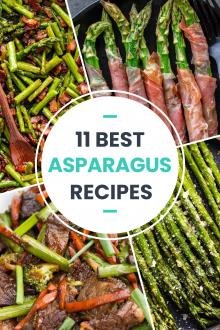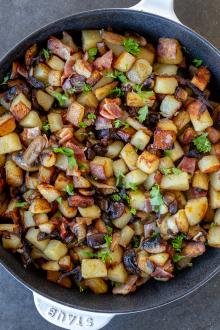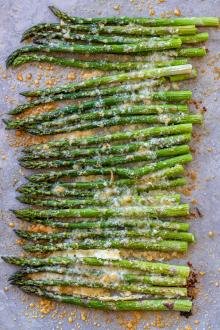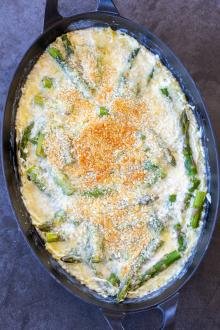This sauteed asparagus recipe uses only three ingredients and takes minimal prep. It’s savory, salty, and scrumptious — a perfect side dish all around!

Every person has their favorite vegetables — for my husband Tim, asparagus is high up on his list of favorites. He loves them baked, grilled, and especially sautéed. And I don’t complain! This sauteed asparagus recipe is so crazy easy that I don’t even consider it as “effort” when it comes to getting dinner on the table. So, what makes it so simple and easy? It’s because it takes less than 10 minutes of prep and cook time and uses my all-time favorite and “secret” ingredient — garlic parsley salt. This ingredient is incredible, I tell ya!
Hot tip: Don’t forget to trim your asparagus. Trimming is easy — rinse the stalks, then use a knife to cut off the light colored, tough ends or bend the stalk with your hands to naturally break the ends off. Make sure to dry the asparagus well before cooking!

How to Saute Asparagus
Making sautéed asparagus is as easy as 1-2-3. Literally — there’s only three steps.
- Trim the asparagus: Trim off the woody ends of each piece of asparagus and slice the stalks into 2-inch pieces (or leave them long if you prefer).
- Sauté the asparagus: Preheat a large skillet over medium heat with olive oil. Toss in the asparagus and sauté for 3-4 minutes or until they’re tender.
- Season the asparagus: Season the asparagus with garlic parsley salt right when it comes off the heat and enjoy!
Hot tip: This asparagus is best served and enjoyed fresh, but if you have leftovers, store them in an airtight container in the fridge for up to five days. Reheat them over medium-high heat in a skillet with a couple of tablespoons of oil or butter.


Tips for the Best Sautéed Asparagus
I like to give you all a few tips with each recipe, but I’ll be honest — this one is so easy that I really had to think about tips that you don’t already know! Here’s a few tips that you may already be familiar with but are great reminders nonetheless.
- Slice the asparagus evenly: To promote even cooking, slice the asparagus spears into pieces that are roughly the same size.
- Keep the heat on medium: To avoid burning the outside of the asparagus and undercooking the inside, keep the heat on medium.
- Use fresh asparagus over frozen: Frozen asparagus has a super hard time crisping up due to the high moisture content. Opt for fresh and you’ll be golden!
Additional Toppings & Flavors
Looking to elevate your easy sautéed asparagus? Here’s a couple of topping and flavor ideas to play around with.
- Cheese: Top the asparagus with Parmesan cheese, feta cheese, or a couple of spoonfuls of goat cheese after removing it from the pan for a cheesy, salty spin.
- Nuts: Toast up some pine nuts, walnuts, or slivered almonds and sprinkle them right on top.
- Fresh Herbs: For a pop of freshness, sprinkle on some fresh dill, chives, or basil.
- Citrus: Toss the asparagus with a drizzle of fresh lemon juice or a couple of shavings of lemon zest for a citrusy flavor.
- Hot & Spicy: Sauté the asparagus with freshly minced garlic cloves, black pepper, and red pepper flakes for an extra pop of flavor.
- Oil Swap: Feel free to swap the olive oil with garlic butter or sesame oil for an Asian taste.
Hot tip: Sautéed asparagus is the perfect complement to your favorite proteins or carbohydrates at the dinner table. My family likes them with cast iron ribeye steaks, air fryer salmon, or baked potatoes.
More Tasty Asparagus Recipes
- Air Fryer Asparagus (So Easy) – Crispy, no-guilt air fried asparagus
- Chicken & Mushrooms with Asparagus – Simple chicken and veggie stir-fry
- Asparagus with Bacon (So Easy) – Chopped asparagus with bacon bits
- How to Steam Asparagus – Guide on perfectly steamed asparagus stalks










I only eat asparagus freshly harvested from my garden, store bought from South America, or Mexico, or even local is just not as good, cooked within minutes after harvesting. Makes all the difference, I pick and eat every day for 6 weeks then its over until next year. Butter salt and pepper, is all it needs, it's perfect that way, from garden to dinner plate in less than 15 minutes. it couldn't be better.
I love home grown veggies. They taste so much better, and that's so awesome that you grow your own.
It really is the best!! Lightly seasoned, tender, & so good! I could eat this with every meal!
I love how versatile apsparagus is, I'm glad you enjoyed it as well, Kristyn!
After a couple weeks of eating it every day I start to add in new ways to eat it, I love it in my scrambled eggs, I pickle a few pints, I often eat it raw especially while I'm cutting it my Springer Spaniel always accompanies me she loves the asparagus as much as I do.
This is my favorite way to make asparagus! It's so easy and really lets the natural flavors of the asparagus shine through. We love eating it as a side dish, but also add it to pasta too!
Oh adding it to pasta is a great call, Taylor! Asparagus is versatile like that. 🙂
Super easy to make and delicious. I appreciate this recipe so much!
Thank you, Jan! We love the easy, simple recipes around here 🙂